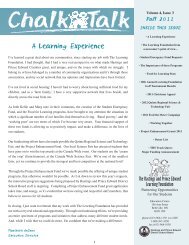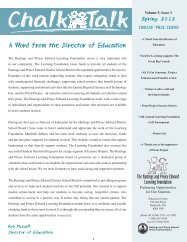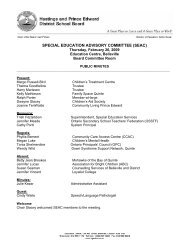The Three Cueing Systems - HPEDSB
The Three Cueing Systems - HPEDSB
The Three Cueing Systems - HPEDSB
Create successful ePaper yourself
Turn your PDF publications into a flip-book with our unique Google optimized e-Paper software.
Hastings and Prince Edward District School Board<br />
C.O.D.E Project, 2007<br />
<strong>The</strong> <strong>Three</strong> <strong>Cueing</strong> <strong>Systems</strong><br />
Sample Questions, Instructional Strategies and Examples of MSV Cues<br />
Written and developed by:<br />
Cassandra Bellwood, Kente P.S.<br />
Kerri Denyes, Princess of Wales P.S.<br />
Lisa Friar, Foxboro P.S.<br />
Cassandra Windsor, Harmony P.S.<br />
Kim Mahoney, C.O.D.E. Project Leader
What is it? Does it make sense?<br />
<strong>The</strong> <strong>Three</strong> <strong>Cueing</strong> <strong>Systems</strong><br />
Meaning (Semantic) Structure (Syntactic) Visual (Graphophonic)<br />
making sense of text and<br />
relaying meaningful connections<br />
context clues found in the text<br />
and/or background knowledge<br />
(comes from the students own<br />
experiences)<br />
Does it sound right?<br />
making sense of the actual<br />
words in the sentences<br />
structural cues come from the<br />
students knowledge of correct<br />
oral language structures<br />
the way in which language is<br />
put together into sentences,<br />
phrases, paragraphs, etc.<br />
Does it look right?<br />
breaking words down into letters,<br />
sounds, syllables, prefixes,<br />
chunks, etc.<br />
visual cues come from students<br />
developing knowledge of<br />
letter/sound relationships and of<br />
how letters are formed<br />
what letters and words look like<br />
often identified as sounding out<br />
words
<strong>The</strong> <strong>Three</strong> <strong>Cueing</strong> <strong>Systems</strong><br />
Meaning (Semantic) Structure (Syntactic) Visual (Graphophonic)<br />
Instructional Ideas Teachers need to teach genres,<br />
or nature of text forms, purpose<br />
for reading, does the word fit,<br />
what information do the<br />
illustrations provide and what<br />
has happened so far.<br />
vocabulary lists<br />
oral predicting<br />
story line prompts<br />
prior knowledge<br />
pictures<br />
connections<br />
webs<br />
graphic organizers<br />
context clues, pictures, text<br />
reading the room<br />
“how to choose a book”<br />
KWL<br />
anticipation guides<br />
Teaching suggestions are to<br />
model more complex sentence<br />
structures and sentence<br />
reconstruction with familiar<br />
stories.<br />
Behaviours that capitalize on<br />
structure; reading ahead, and re<br />
reading<br />
cut up sentences<br />
guess the covered word<br />
natural language<br />
knowledge of English<br />
Do the sounds and the words I am<br />
reading match the words on the page<br />
(phonological awareness cueing<br />
system)<br />
making big words<br />
month by month phonics<br />
word sorts<br />
word analogies<br />
sounds and symbols<br />
capitalization<br />
punctuation<br />
directionality<br />
word and spaces<br />
beginnings and endings<br />
word families<br />
root words<br />
syllables<br />
prefixes and suffixes<br />
magnetic letters
Sample Questions and Prompts to Promote Students’ Use of the <strong>Three</strong> <strong>Cueing</strong> <strong>Systems</strong><br />
Meaning (Semantic) Structure (Syntactic) Visual (Graphophonic)<br />
Questions & Prompts What do we know about this<br />
topic already?<br />
What do we need to know?<br />
What would help us<br />
understand this text?<br />
Why are we reading this book?<br />
What other books have we<br />
read on this topic?<br />
What is going to happen next?<br />
What predictions can you<br />
make about this text?<br />
What could have happened<br />
before this story? What could<br />
happen after?<br />
Show where in the text it says<br />
that. Show where the author<br />
indicated that.<br />
If a student is relying primarily on<br />
meaning, it will be beneficial to<br />
support her reading strategies that<br />
promote looking at letters and sounds.<br />
When I covered up this word<br />
in the text, how did you know<br />
what word would be<br />
appropriate?<br />
When I was reading and left<br />
out a word, how did you now<br />
what word was in the text?<br />
Have you hear that<br />
phrase/language (e.g. Once upon<br />
a time ...) before?<br />
If a reader is relying primarily on<br />
structure, it will be beneficial to<br />
support her reading with strategies that<br />
promote meaning and visual cues.<br />
What were the rhyming words in<br />
this story?<br />
What would do you see within that<br />
bigger word? (prompt students to<br />
look for the root word in a word<br />
with a prefix or a suffix, or for the<br />
two words that make up a<br />
compound word.)<br />
What is the first letter (or last<br />
letter) of the word?<br />
What sound does that letter (or<br />
combination of letters) make?<br />
What other words start with that<br />
letter and would fit into this<br />
sentence?<br />
If a reader is relying primarily on visual<br />
cues, it will be beneficial to support her<br />
reading with strategies that promote<br />
meaning and structure.
An example of a reader using MEANING cue,<br />
purring<br />
<strong>The</strong> small cat was sitting quietly by the window.<br />
In this example, the substitution of purring for quietly made sense to the<br />
reader, especially considering her personal experience and interest in cats.<br />
<strong>The</strong> reader may have also recently read another book about cats where the<br />
cat purred.<br />
An example of a reader using STRUCTURAL cue,<br />
standing<br />
<strong>The</strong> small cat was sitting quietly by the window.<br />
In this example, the substitution of standing for sitting follows the rules of<br />
langauge, and does not present a grammatical problem.<br />
An example of a reader using VISUAL cue,<br />
smell<br />
<strong>The</strong> small cat was sitting quietly by the window.<br />
In this example, the substitution of smell for small shows that the reader<br />
used the bveginning blend as well as the middle consonant L, possibly<br />
recognizing the double L pattern in the word smell.<br />
Examples of MSV Cues<br />
An example of a reader NOT using a meaning cue,<br />
quetty<br />
<strong>The</strong> small cat was sitting quietly by the window.<br />
In this example, the substitution of quetty for quietly does not make sense.<br />
Not only is quetty noa word but the rest of the sentence doesn’t make sense<br />
as a result of the error. Meaning was not used on the word or sentence level<br />
in this example.<br />
An example of a reader NOT using a structural cue,<br />
sat<br />
<strong>The</strong> small cat was sitting quietly by the window.<br />
In this example, the substitution of sat for sitting creates a grammatical<br />
error and does not follow the rules of language.<br />
An example of a reader NOT using a visual cue,<br />
lettle<br />
<strong>The</strong> small cat was sitting quietly by the window.<br />
In this example, the substitution of little for small indicates that the cues for<br />
the letters were not used. Neither the beginning, end or chunk within the<br />
word is similar visually.
















